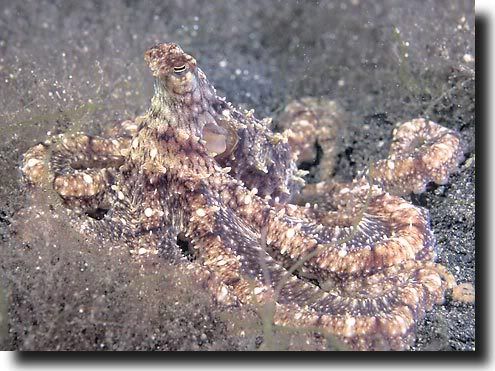Via MarineBio.org
Octopus cyanea
Day Octopus
Kingdom: Animalia
Phylum: Mollusca
Class: Cephalopoda
Order: Octopoda
Family: Octopodidae
Genus: Octopus
species: Octopus cyanea
The Day octopus, Octopus cyanea (Gray, 1849), aka Cyane's octopus or Big blue octopus, is a large octopus, with a body to at least 16 cm and arms to at least 80 cm, typically brown in color but with the ability to rapidly change color and skin texture. This octopus is characterized by dark oval false eye-spots with no iridescent rings commonly present at the base of its arms and the the dark brown coloring on the tips of the arms along with 2 rows of lighter spots. The dark eye-spots are only sometimes visible and depends upon the patterns being displayed by individual octopuses. Because this species feeds during daylight hours, its ability to camouflage are exceptional. The Day octopus can produce a variety of color patterns and elaborate skin textures that resemble the ocean substrate around them making them virtually invisible to predators. Their complex brain sends nervous impulses to their muscles causing them to change almost instantly as they move over sand, coral, rubble and other surfaces. One Day octopus was observed by octopus biologist Roger Hanlon changing patterns 1,000 times over a 7 hour period off the coast of Hawaii.
World Range & Habitat
The Day octopus, Octopus cyanea, is a common octopus found throughout the Indo-Pacific region, off eastern Africa and the Red Sea to the Hawaiian Islands. This octopus excavates lairs in coral reefs and associated rubble which can be located by identifying "middens" outside the lair entrance which are typically the empty shells of bivalves and crabs which it has preyed upon.
Labels: Características



0 Responses to “Pulpo camaléon -Octopus Cyanea-”
Leave a Reply